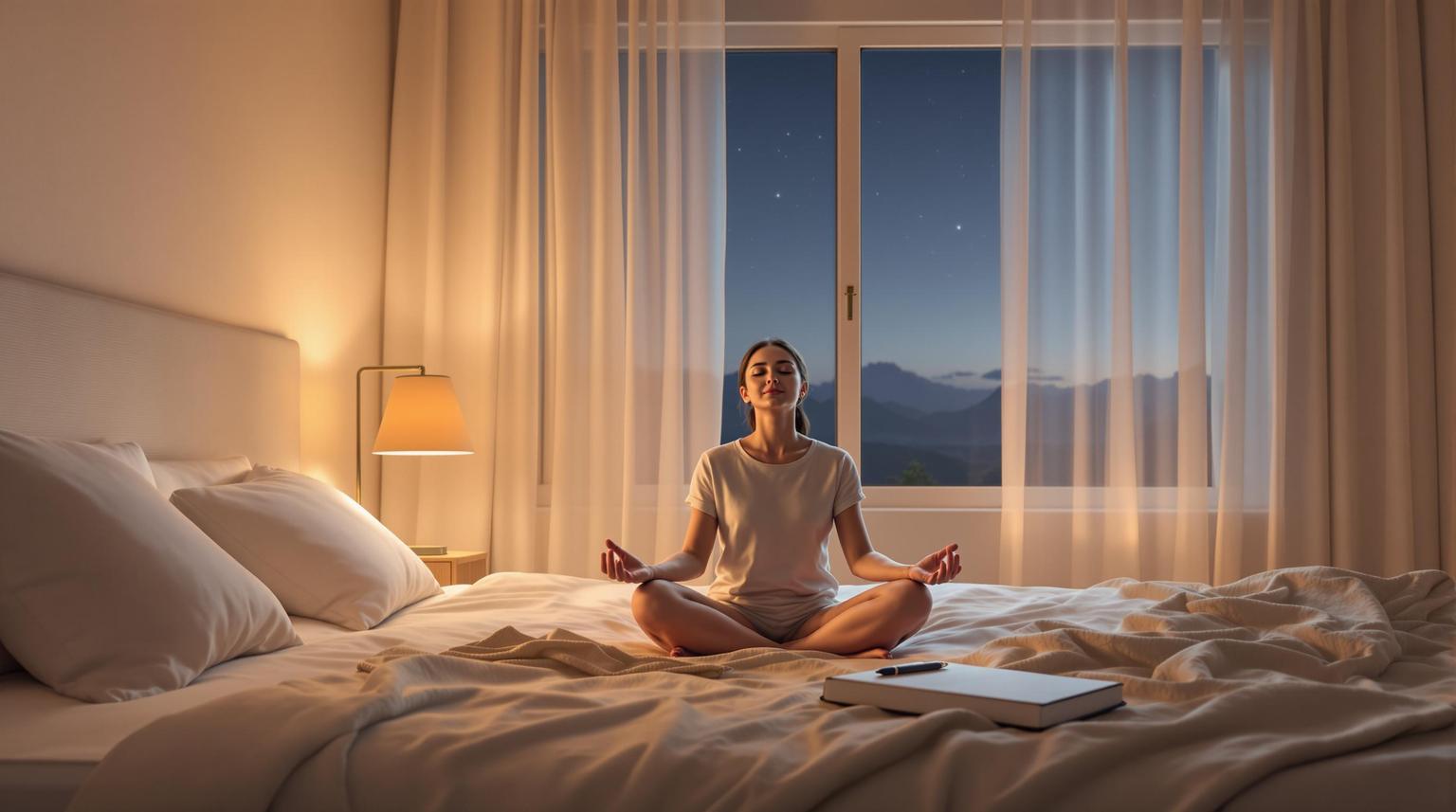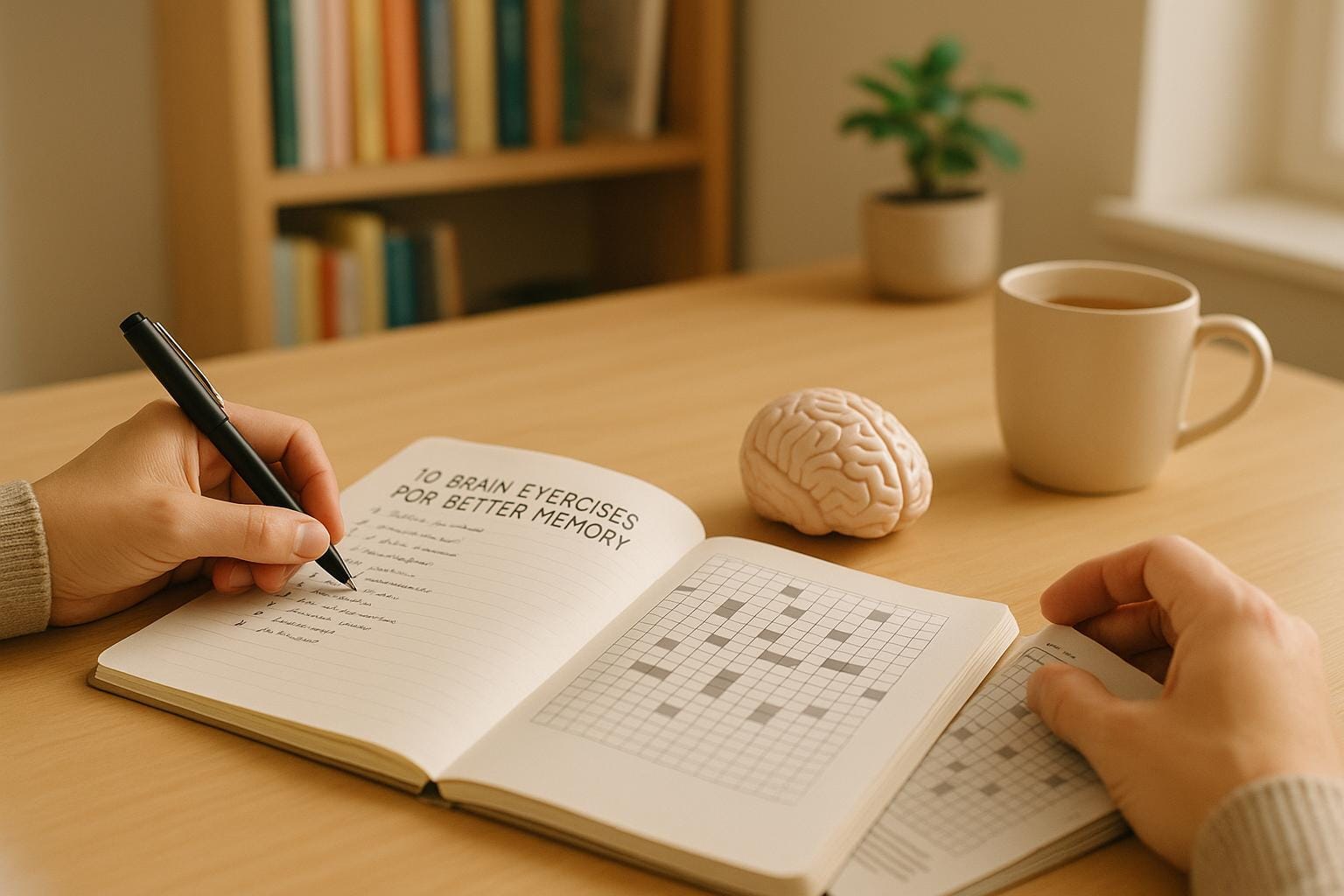Struggling with racing thoughts at night? Here are 5 mindfulness techniques to help calm your mind and improve your sleep:
- Cognitive Shuffling: Redirect your mind by focusing on random, neutral words or images.
- 4-7-8 Breathing: Use controlled breathing to activate your body’s relaxation response.
- Progressive Muscle Relaxation: Tense and release muscles to ease physical tension.
- Journaling: Write down worries or to-do lists to clear mental clutter.
- Understanding Anxiety's Impact: Learn how stress and cortisol disrupt sleep and how mindfulness can help.
These methods work by addressing both mental and physical stress, creating a peaceful transition to sleep. Start with one technique tonight and build a routine that works for you.
Anxiety & Racing Thoughts at Night: 3 Simple Ways to Sleep Better
1. How Racing Thoughts Affect Your Brain at Night
To understand how mindfulness can improve your sleep, it’s important to first grasp how racing thoughts disrupt it. These thoughts stem from brain processes that stay active long after the day’s distractions fade. When you lie down at night, your brain doesn’t just “shut off.” Instead, several systems interact, either guiding you toward restful sleep or keeping you wide awake.
Throughout the day, your brain juggles countless sensory inputs - from conversations and traffic noise to visual and physical stimuli. But at night, the default mode network takes over. This network, responsible for internal self-reflection, often amplifies worries and fuels a cycle of rumination, especially for those experiencing anxiety.
Scientific research reveals that insomnia involves multiple brain networks working overtime. These include the executive control network and key subcortical regions like the thalamus and hypothalamus, which are typically responsible for regulating sleep-wake cycles. When stress or anxiety disrupts these systems, your brain can remain stuck in a hyperactive state, making restful sleep elusive.
How Anxiety Creates Sleep Problems
Anxiety and sleep issues are closely intertwined - each one can make the other worse. When anxiety strikes, your body’s stress response system kicks into gear. This triggers physiological changes like a racing heart, tense muscles, and rapid breathing, all of which make it harder to relax and drift off.
In fact, nearly 75% of people with anxiety disorders report some form of sleep disturbance, and about 50% experience chronic sleep problems. For individuals with post-traumatic stress disorder (PTSD), the numbers are even higher - over 90% report symptoms of insomnia. Those with anxiety disorders also tend to have higher sleep reactivity, meaning even small stressors during the day can significantly disrupt their sleep.
Even your bedroom can become a source of anxiety. If you frequently worry while lying in bed, your brain may start associating that space with stress rather than relaxation.
"When our thoughts are stressful, our bodies respond in a similar fashion, and our fight-or-flight system is activated."
- Michelle Drerup, PsyD, DBSM
"The bed itself becomes associated with worry and anxiety."
- Michelle Drerup, PsyD, DBSM
How Cortisol Disrupts Sleep Stages
Cortisol, often called the stress hormone, has a direct impact on sleep quality. Under normal circumstances, cortisol levels rise in the morning to help you wake up and gradually decrease by bedtime, signaling your body to prepare for sleep. But stress and anxiety can throw this rhythm off by overactivating the hypothalamic-pituitary-adrenal (HPA) axis, leading to elevated cortisol levels at night.
When cortisol stays high, it creates a state of heightened arousal that disrupts both falling asleep and staying asleep. Research links increased activity in the HPA axis to more fragmented, restless sleep, reduced deep sleep (the restorative slow-wave phase), and shorter overall sleep duration. Worse still, sleep deprivation itself can cause your body to produce even more cortisol during the day, creating a vicious cycle where poor sleep feeds into higher stress levels, which then further disrupt sleep.
Understanding these mechanisms lays the groundwork for mindfulness techniques that can help calm your brain and encourage better sleep. Next, we’ll dive into strategies that redirect this overactivity and support restful nights.
This article is for informational purposes only and is not intended as medical advice. Please consult a healthcare professional before starting any new fitness or wellness routine.
2. Use Cognitive Shuffling to Redirect Your Mind
Cognitive shuffling is a mindfulness technique designed to steer your mind away from anxiety, especially when racing thoughts keep you awake at night. Developed by cognitive scientist Dr. Luc Beaudoin, this method taps into the natural randomness your brain experiences as you drift off to sleep. Instead of trying to force your thoughts to stop - a tactic that often backfires - cognitive shuffling shifts your focus to neutral, non-emotional content, providing your brain with something calm to anchor itself to.
This approach mimics what happens naturally as you transition from wakefulness to sleep. During this phase, your thoughts become fragmented and random, a phenomenon researchers call "microdreams." Cognitive shuffling helps simulate this state, signaling to your brain that it's time to relax.
How to Do Cognitive Shuffling
Start by creating a sleep-friendly environment. Dim the lights, put away your phone, and arrange your pillows. Using a fan or white noise machine can also help block out distractions.
Next, pick a simple, neutral word - something you encounter daily, like "chair", "water", or "table." Avoid words that might stir strong emotions or memories. Once you've chosen your word, break it down letter by letter, thinking of other words that start with each letter. For example, if your word is "table":
- T - tree, train, towel
- A - apple, arrow, ant
- B - book, bottle, balloon
- L - lint, lily, lamp
- E - eagle, egg, elephant.
The goal isn’t to complete the list but to let your thoughts wander naturally. If you run out of ideas for a letter, just move on to the next one. Still awake after finishing? Pick a new word and start again. Alternatively, you can try visualizing random, unconnected objects or scenes, and some people find it helpful to switch between word-based and imagery-based approaches. If you wake up in the middle of the night, repeat the exercise and avoid reaching for your phone.
This technique can also complement other mindfulness practices, setting the stage for a smoother transition to sleep.
Why Cognitive Shuffling Works
The magic of cognitive shuffling lies in how it redirects your brain's energy. When anxiety takes over, your brain's executive control networks keep you alert and on edge. By focusing on simple, unrelated words or images, you engage different brain pathways, helping your mind relax.
Studies back this up. In research involving 154 college students, those who practiced cognitive shuffling reported better sleep quality, found it easier to fall asleep, and experienced less presleep arousal. Many even said they drifted off within 5 to 15 minutes.
"We think there's a positive feedback loop in the brain: Microdreams are not just a product of falling asleep; they cue the brain that it is safe and appropriate to fall asleep." – Dr. Luc Beaudoin
By introducing randomness, this technique mimics the natural thought patterns that occur as your brain prepares for sleep. This randomness acts as a signal, letting your mind know it's time to rest.
"The randomness of these words also mimics the random thoughts that our brain drifts to as it prepares for sleep." – Dr. Brintha Vasagar
If you find frustration creeping in or it takes longer than 20 minutes to feel sleepy, try switching to a different relaxation method.
"I always tell patients, 'You cannot force yourself to sleep. You have to allow yourself to sleep.' And this is just one of the methods that we use to help with that." – Dr. Fariha Abbasi-Feinberg, Sleep Medicine Physician and Neurologist
This article is for informational purposes only and does not replace medical advice. Consult a healthcare professional before starting any new wellness routine.
3. Try 4-7-8 Breathing to Calm Your Body
When it’s time to sleep, racing thoughts can set off a chain reaction - your heart pounds, muscles tense up, and restful sleep feels impossible. The 4-7-8 breathing technique is a straightforward way to interrupt this cycle. Rooted in the ancient yogic practice of pranayama and popularized by Dr. Andrew Weil, it’s often described as a "natural tranquilizer for the nervous system". This method works by engaging your parasympathetic nervous system, which is responsible for the "rest and digest" response. The result? A slower heart rate, lower blood pressure, and a body that’s ready to relax. It’s also a great complement to mindfulness practices, helping shift your focus from anxious thoughts to calm awareness.
"The 4-7-8 breathing technique allows you to relax the sympathetic nervous system, which is responsible for the 'fight or flight response,' while it activates your parasympathetic nervous system to bring you back to a normal heartbeat, deeper breathing and a calmer mind."
– Dr. Olivia Hsu Friedman, Doctor of Acupuncture, Traditional Chinese Medicine and Herbal Medicine at Amethyst Holistic Skin Solutions
Studies back this up, showing that 4-7-8 breathing can improve heart rate variability, lower blood pressure, and ease anxiety symptoms. In fact, a 2023 review found that just five minutes of slow, controlled breathing can significantly reduce stress and anxiety.
How to Practice 4-7-8 Breathing
You can practice this technique while sitting upright with a straight back or lying down comfortably. Proper tongue placement is key: rest the tip of your tongue against the roof of your mouth, just behind your top front teeth.
Here’s how to get started:
- Exhale: Begin by breathing out completely through your mouth with a soft "whoosh" sound, emptying your lungs.
- Inhale: Breathe in quietly through your nose for a count of 4 seconds, filling your lungs steadily.
- Hold: Hold your breath for 7 seconds. It might feel tricky at first, but it gets easier with practice.
- Exhale: Breathe out fully through your mouth for 8 seconds, again making that gentle "whoosh" sound.
Repeat this cycle four times to start. As you grow more comfortable, you can gradually increase the number of cycles. If you feel lightheaded at first, don’t worry - this is normal. Start slowly and listen to your body. For the best results, practice this technique twice daily: once in the morning and once before bed. Over time, this simple routine can help train your nervous system to handle stress more effectively, setting the stage for deeper relaxation.
How Breathing Exercises Help Sleep
Once you’ve mastered the 4-7-8 technique, it not only calms your body but also prepares your mind for sleep. The beauty of this practice lies in its simplicity. Shifting your focus to the rhythm of your breath distracts you from racing thoughts, creating a peaceful mental space.
"Yoga breathing techniques calm the body down and bring it into a more relaxed state. This kind of breathing can help us focus our mind and our body away from worries and repetitive thoughts."
– Melissa Young, MD, Integrative Medicine Specialist
The extended exhale is particularly effective - it signals your body to relax, slowing your heart rate and lowering blood pressure. These physiological changes send a clear message: it’s time to rest. Plus, the structured rhythm of counting gives your mind something simple to focus on, helping to break the cycle of nighttime anxiety. Some people even report falling asleep in under a minute.
What’s more, regular practice - even when you’re not feeling stressed - can train your body to relax on cue. A 2020 review highlighted that deep breathing exercises may enhance heart and lung function, lower blood pressure, and improve quality of life for people with chronic conditions. While more research is always welcome, there’s already strong evidence that these techniques offer benefits far beyond relaxation.
This article is for informational purposes only and is not intended as medical advice. Please consult a healthcare professional before starting any new fitness or wellness routine.
4. Practice Progressive Muscle Relaxation to Release Tension
When racing thoughts take over, your body often mirrors that mental chaos with physical tension - tight shoulders, a clenched jaw, or stiff muscles. This is where Progressive Muscle Relaxation (PMR) steps in, offering a hands-on way to calm both body and mind. Developed by Dr. Edmund Jacobson back in the 1920s, PMR is rooted in the idea that relaxing your muscles can naturally quiet your mind.
By focusing on specific muscle groups, tensing them, and then releasing, PMR helps your body shift from a high-alert state to one of deep relaxation. It’s a simple yet powerful technique that teaches your nervous system to recognize and let go of tension. This physical approach complements mental strategies by directly addressing the stress your body holds onto.
"Progressive relaxation is like a body scan that has a mental component and a physiological component. It involves using breathing and visualization to help you acknowledge and release the tension you hold in every area of your body."
– Matthew Kampert, DO, Sports Medicine Physician
One of the best parts? PMR is easy to learn and doesn’t take much time - just 10 to 20 minutes a day. In fact, the American Academy of Sleep Medicine has recognized PMR as an effective, non-drug treatment for chronic insomnia since 1999.
How to Do Progressive Muscle Relaxation
To get started, find a quiet spot where you can sit or lie down comfortably. Begin with a few deep breaths, inhaling slowly through your nose and exhaling with an audible sigh. Then, systematically work through your body, focusing on the contrast between tension and relaxation:
- Lower Body: Curl your toes tightly, then release and notice the change. Flex your feet upward, then let them go limp.
- Calves: Point your toes downward to tense your calf muscles, hold briefly, then relax.
- Thighs and Buttocks: Squeeze these larger muscles, hold the tension, and then let go.
- Abdomen: Draw your belly button toward your spine, hold, and then soften your stomach muscles.
- Hands and Arms: Clench your fists and tighten your arms, then release and let them feel heavy.
- Shoulders: Lift them toward your ears, hold, and then drop them completely.
- Head and Face: Scrunch your forehead, clench your jaw, and then relax.
As you move through each muscle group, sync your breathing with the process: inhale as you tense and exhale as you release. If your mind starts to wander, gently bring your focus back to your breath and the sensations in your body.
The Science Behind Progressive Muscle Relaxation
PMR isn’t just a feel-good practice; it’s backed by solid research. A 2020 study revealed that participants who practiced PMR for 30 minutes daily over five days saw a 15% drop in anxiety levels and a 30% improvement in sleep quality compared to those who didn’t.
On a physiological level, PMR works by calming your body’s stress response. Dr. Matthew Kampert explains:
"The sympathetic nervous system increases your heart rate and causes muscles to contract. With progressive muscle relaxation, you're trying to calm down that sympathetic output and let your parasympathetic system take over. When that switch happens, you can see a change in your heart rate and blood pressure."
– Matthew Kampert, DO, Sports Medicine Physician
Research also highlights PMR’s ability to boost slow-wave sleep, the deep, restorative stage critical for recovery. Participants in one study spent an extra 10 minutes in this sleep stage - a 125% increase compared to control groups. Beyond improving sleep, PMR has been shown to ease symptoms of depression, anxiety, and stress. It’s even been found to reduce headache frequency and severity by as much as 60% when combined with biofeedback. In some cases, PMR has proven just as effective as acupuncture in alleviating tension, anxiety, and anger.
To get the most out of PMR, practice regularly - even on calm days. Dedicate 15 to 20 minutes in a quiet space, turn off distractions like your phone, and wear loose clothing to stay comfortable. Over time, you’ll become more attuned to the tension your body holds and better equipped to release it, making this practice a valuable tool for managing both physical stress and racing thoughts.
This article is for informational purposes only and is not intended as medical advice. Please consult a healthcare professional before starting any new fitness or wellness routine.
5. Write in a Journal to Clear Your Mind
Journaling, much like cognitive shuffling or breathing exercises, offers a structured way to quiet a busy mind. By writing down your thoughts, you can unload the mental clutter that builds up throughout the day. This helps release worries and allows your brain to stop holding onto every task, emotion, and random idea all at once. The simple act of putting pen to paper gives your mind permission to let go.
Journaling can also serve as a psychological signal that your day is done. It creates a boundary between your waking hours and bedtime. When you write down your worries, it’s like telling your brain, “These are stored safely; you don’t need to keep spinning them in your head.”
"Writing about your thoughts and feelings helps offload the mental clutter that you have been building up throughout the day. It's kind of like emptying the trash bin on your computer. When you process your thoughts on paper, it can allow you to set them aside, leading to a calmer mind that's ready for sleep."
– Suzette Bray, licensed psychotherapist and author
By making journaling a consistent part of your bedtime routine, you create a ritual that signals your body and mind to shift from active thinking into rest mode.
How to Start Bedtime Journaling
Starting a bedtime journaling habit doesn’t have to be complicated. You don’t need fancy notebooks or long, detailed entries. Keep it simple: spend just five minutes writing. Use a pen and paper instead of digital devices to avoid the blue light that can interfere with your sleep hormones.
Set the mood by dimming the lights and perhaps playing soft background music to create a peaceful atmosphere. The goal isn’t to write a masterpiece - it’s to release the thoughts weighing on your mind.
If you’re not sure what to write, try using prompts to guide your thoughts. Alfred James, author of Pocket Mindfulness, suggests a quick five-category approach:
| Prompt Category | Purpose | Example |
|---|---|---|
| Tomorrow's Goal | Set an intention | "Be more grateful" or "Go for a morning run" |
| Today's Achievements | Celebrate accomplishments | "Finished my accounts, yay!" or "Stayed patient" |
| Let it Go | Release worries | "Disagreement with mom - it doesn’t matter, we’re good." |
| Happy Thought for the Day | End on a positive note | "Jennifer’s getting married" or "Yoga was so relaxing" |
| Positivity Score | Rate your mood (1–10) | A simple number to track your overall day |
Focus on gratitude and the good moments in your day to help set a positive tone for sleep. You can also jot down unfinished goals, new insights, or things you’re thankful for. One especially helpful practice is creating a to-do list for the next day. This helps clear your mind of lingering tasks so they don’t keep you awake. The more specific your list, the better it works to free up mental space.
Incorporating journaling into your nightly routine works well alongside other mindfulness techniques, helping you prepare for restful sleep.
Why Journaling Calms Racing Thoughts
Research shows that journaling can help you fall asleep faster by reducing the time it takes to unwind mentally. Studies even found that writing specific to-do lists at bedtime led to quicker sleep onset compared to journaling about completed tasks.
The reason is simple: your brain is wired to solve problems. When you carry unresolved thoughts to bed, your subconscious keeps working on them, which can trigger stress responses, nightmares, and disrupted sleep.
"Journaling is an outlet to help your brain process, sort and problem-solve events, challenges or emotions from the day. Unprocessed to-do lists and worries keep your subconscious active during sleep. This can lead to nightmares, fight-or-flight response and disrupted sleep."
– Angela Williams, LCSW, mindset coach and psychotherapist
Clinical studies back up the benefits of journaling. For example, a 2006 study found that young adults who wrote about stressful events experienced noticeable reductions in symptoms like anxiety, depression, and irritability. Writing down your feelings can also lower stress hormones like cortisol and reduce the intensity of negative emotions. By organizing your thoughts on paper, you create distance from them and often gain a fresh perspective.
To maximize the benefits, aim to journal consistently, ideally 15–30 minutes before bed. Even on calm days, sticking with the habit reinforces the association between journaling and winding down for sleep. Over time, this routine can become a powerful signal for your mind and body to transition into rest mode.
This article is for informational purposes only and is not intended as medical advice. Please consult a healthcare professional before starting any new fitness or wellness routine.
Conclusion: Building Your Nighttime Routine
Your nights don’t have to be ruled by racing thoughts. The five mindfulness techniques we’ve explored - understanding anxiety’s impact on your brain, cognitive shuffling, 4-7-8 breathing, progressive muscle relaxation, and journaling - are practical tools to help calm your mind and set the stage for restful sleep.
To make these techniques work for you, consistency and personalization are essential. Studies show that mindfulness can significantly improve sleep quality, but the key is regular practice. As Dr. David Rosen, a Sleep Medicine Physician, points out:
"Sometimes my patients will tell me my guidance about a bedtime routine is not telling them anything new. I always respond by stressing there is a difference between understanding a concept and really internalizing it as a part of your behavior. We all understand that exercise is important, but that doesn't negate how hard it is to establish and maintain a habit of exercising regularly."
Start small. Pick one practice to try 30 to 60 minutes before bed. Gradually build a routine that feels natural and signals your body it’s time to unwind. There’s no need to tackle all five techniques at once - experiment with one at a time to see what resonates with you.
Keep in mind that mindfulness is a skill that grows with time and patience, not an instant solution. Adjust your routine as your needs evolve. Clinical sleep psychologist Shelby Harris emphasizes:
"Mindfulness can quiet the brain and allow for deeper sleep."
Beyond mindfulness, take steps to create a sleep-friendly environment. Silence your phone, turn off screens, and power down the TV at least 30 minutes before bedtime. A consistent pre-sleep routine helps set a rhythm for your body, making it easier to transition into rest.
Crafting a nighttime routine that works for you takes time, but the rewards are worth it: better sleep and calmer nights. Start tonight with just one technique, and as it becomes second nature, incorporate others into your wind-down. Over time, this mindful approach will help you enjoy peaceful, uninterrupted sleep.
This article is for informational purposes only and is not intended as medical advice. Please consult a healthcare professional before starting any new fitness or wellness routine.
FAQs
What are some practical ways to add mindfulness techniques to my bedtime routine?
To weave mindfulness into your bedtime routine, carve out 20–30 minutes to unwind before hitting the pillow. Use this time for relaxing activities like reading a favorite book, soaking in a warm bath, or doing some gentle stretches. Adding deep breathing exercises or a brief meditation that focuses on your breath can also work wonders to calm your mind and release tension.
Another great approach is writing down any nagging thoughts or concerns in a journal before bed. This practice, often referred to as a "brain dump", helps clear mental clutter and shifts your focus toward relaxation. By sticking to these habits, you’ll build a comforting nightly routine that supports restful sleep and a more peaceful mind.
What can I do if I have trouble focusing during cognitive shuffling or other mindfulness exercises?
If focusing feels tricky during cognitive shuffling or mindfulness exercises, here are a few ways to make it easier:
- Cut out distractions: Find a quiet, cozy spot where you won’t be interrupted by noise or other disturbances.
- Ease into it: Start with shorter sessions and slowly increase the time as you get better at staying focused.
- Try guided help: Use guided meditations or recordings designed to keep you on track.
- Be kind to yourself: Losing focus happens - it’s part of the process. When your mind wanders, just gently guide it back without being hard on yourself.
Stick with it, and over time, you’ll likely find it easier to stay focused during these exercises.
Can mindfulness techniques for better sleep have any risks or side effects?
While mindfulness techniques are often praised for their ability to calm the mind and improve sleep, they aren't without potential downsides. For some, especially those with a history of mental health challenges, mindfulness can sometimes bring up unintended effects. These might include heightened anxiety, trouble sleeping, or even resurfacing memories of past trauma. In rare instances, more intensive mindfulness practices have been linked to severe reactions like psychosis, particularly in individuals with pre-existing psychological conditions.
If you find yourself experiencing any negative effects, it’s wise to scale back - try shorter or less intense sessions. And don’t hesitate to reach out to a mental health professional for personalized advice. The goal of mindfulness is to enhance your well-being, so pay attention to how your mind and body respond as you integrate these practices into your daily life.












